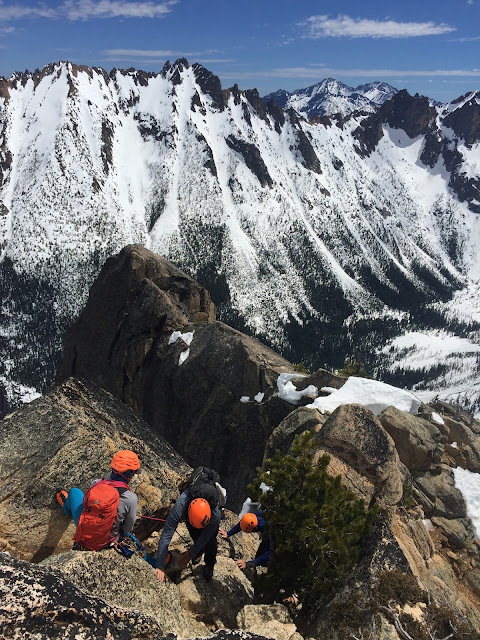--A car fire near Squamish at Cat Lake may have taken the life of a Vancouver-based climber. Though the reports haven't been verified yet, it's believed that Jesse James was killed in the fire. Homicide detectives have been investigating the incident. To read more, click here.
--A skier was airlifted off Mt. Baker on Saturday. To read more, click here.
--Former AAI Guide Forest McBrian and his partner recently skied from Snoqualmie Pass to the Canadian Border. This was the largest Cascade link-up in history. To read about it, click here.
--Komo News is reporting that, "About 70 volunteers managed to get an injured climber down a mountain in eastern Snohomish County to a spot where he could be picked up by a helicopter. The climber, a 27-year-old Seattle man, was taking part in a climbing class Saturday when he fell and broke his ankle on Sloan Peak. A climbing instructor activated a personal locator beacon, sending GPS coordinates to the Air Force Rescue Coordination Center in Florida, the Snohomish County Sheriff's Office says." To read more, click here.
Sierra:
--There was a climber injury near Donner Pass on Saturday. There's limited information at this point. To read more, click here.
--There is a lot of snow in the Sierra this year. And the PCT is super busy this year. This combination has not been good for thru-hikers and there have been many rescues and close calls. To read more, click here.
Desert Southwest:
--There was a small brush fire in Joshua Tree National Park last week. To read more, click here.
Colorado:
--Fox 31 is reporting that, "An injured climber was rescued after falling 20 to 25 feet in Boulder Canyon on Wednesday night, the Boulder County Sheriff’s Office said." To read more, click here.
Alaska:
--The Alaska Dispatch is reporting that, "An official with the Walter Harper Talkeetna Ranger Station identified the mountaineer who died Friday, June 16, on Denali as Sanjay Pandit, 28, of Kathmandu, Nepal, spokeswoman Maureen Gualtieri wrote in a release. According to the release, Pandit died at 17,500 feet on Denali’s West Buttress route. The climber’s remains will be recovered from the 17,200-foot high camp when the cloudy and windy weather conditions improve. To read more, click here.
--AAI's final Denali team is approaching the summit. To read more, click here.
--Gripped is reporting that Katie Bono recently set the women's speed record on Denali. With a time of 21:06 she ripped up and down the mountain. To read more, click here.
Notes from All Over:
--Two people were killed by black bears in Alaska last week. One of the victims was a 16-year old in an adventure race. It has been reported that the maulings were predatory, which is incredibly unusual. To read more, click here.
--So a woman was attacked by a rabid raccoon in Maine. The attack ended with the raccoons death in a puddle... To read this weird news item, click here.
--Powder magazine is reporting that, "a study released in April by a group of scientists in Colorado underscores what many have already known will happen to the ski industry as a result of climate change. But their research paints a clearer picture of the future. The scientists ran five climate models under two different scenarios of greenhouse gas emissions for the years 2050 and 2090, and then monetized the impact by using average lift ticket prices." Their conclusions are grim for the ski industry... To read more, click here.
--The New York Times and others are reporting that, "after 42 years on the endangered species list, the Yellowstone grizzly bear — whose numbers have grown to more than 700 from fewer than 150 — will lose its protected status, the Interior Department announced on Thursday." To read more, click here.
--CBC is reporting that, "Martina Halik and her mother Tania have just completed a cross-country ski trip from Squamish to Skagway, Alaska, traversing the entire length of the Coast Mountains. It's a feat they say has only ever been accomplished once before." To read more, click here.


















